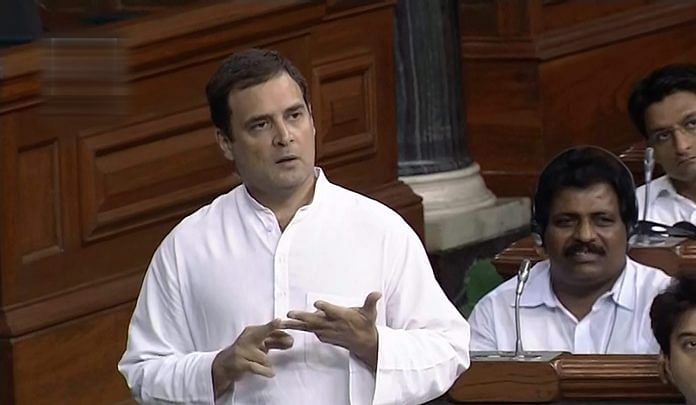Amidst high drama of no-confidence motion against Modi govt, what seems to have gone unobserved is the implication of division of votes on 2019 elections.
The reactions to the no-confidence motion debate in the Lok Sabha Friday could be placed in three neat categories. Those who supported the motion praised Rahul Gandhi’s efforts in attacking PM Narendra Modi and his government’s record on many fronts. They saw his hug to the PM as a good gesture and a brilliant move. Those who opposed the motion and had a good laugh at the jibes PM took on Rahul Gandhi, and they also seemed satisfied with the NDA government’s report card. And finally, those who believed that the debate on the motion of no-confidence, a sacred instrument in parliamentary democracies to hold the government accountable, was reduced to farce and theatrics.
The moment could have been used to generate a substantive discussion on the issues that are facing our country today, but alas, the platform got converted into a theatre of mudslinging.
While everyone was well aware that the government had the numbers in the house and would comfortably sail through, the focus was largely on how Rahul Gandhi would use the occasion to energise the opposition for the 2019 general elections, and on Narendra Modi’s counter-attack. Amidst the high drama what seems to have gone unobserved is the implication of division of votes on the motion. The motion was defeated by 126 to 325 votes suggesting that almost of one-sixth of MPs either walked out from the debate or were absent.
The government received more votes than its current strength in the house, while the opposition with a bench strength of approximately 150 MPs could muster only 126 votes. This is a clear sign that the mahagatbandhan of opposition parties for the 2019 elections is yet to materialise. The BJP-led NDA, excluding the speaker, has 312 MPs in the house. This got reduced to 294 as the Shiv Sena (18 MPs) walked out from the debate. Nonetheless, the government managed to garner the support of 325 MPs indicating that a large number of AIADMK MPs voted with the government. If such a bonhomie between the BJP and the AIADMK continues, rest assured that despite the split in AIADMK after Jayalalitha’s sudden demise, the party may play a crucial role in the 2019 government formation after elections.
The Biju Janata Dal (BJD) with 19 MPs and the Telangana Rashtra Samithi (TRS) with 11 MPs too abstained from the debate. Their plan seemed to be to stay clear from the game in the national capital and keep all options open to continue holding the fort in the state capital. The BJP has a negligible presence in Telangana and the TRS is likely to be in competition with the Congress or (and) the Telugu Desam Party (TDP) for the state assembly election scheduled to happen alongside the Lok Sabha one. Thus, both the BJP and the TRS could serve each other’s purpose well.
This motion of no-confidence against the government was moved by the TDP after its severed ties with the BJP last year. The motion was supported by the YSR Congress (TDP’s main challenger in the state) and also by the Congress (which seems to have become a non-player in the state’s politics). While the TDP attacked the government for not doing enough for Andhra Pradesh after the bifurcation, it also blamed the Congress party in equal measure. The Prime Minister, however in his reply to the motion, stayed clear from saying anything against the TDP or the YSR Congress. The approach was pretty obvious: the BJP would need an ally in Andhra Pradesh and the party is more comfortable aligning with the TDP, but it would not mind crossing the bridge if push comes to shove.
The same strategy seems to be at work with the Shiv Sena, the BJP’s oldest ally. While it is a part of the BJP-led governments in Mumbai as well as in New Delhi, the party has remained vocal against Narendra Modi and BJP president Amit Shah for quite some time now. It may be a good tactic to play the hide and seek game on TV cameras, but the Shiv Sena may end up paying a huge price by continuing with this tactic. A hide and seek strategy may suit balance of power games but is likely to hurt effective voter mobilisation on the ground during elections. This possibility may create internal divisions within the party’s legislators who would like to get re-elected and may lead to a split.
The most intriguing part of Friday’s high drama session, however, was the BJD’s decision to abstain. The BJP has made serious inroads in Odisha since 2014 and is likely to emerge as a key challenger to Naveen Patnaik’s two-decade-old regime in the state. Odisha too would vote for the state assembly along with the Lok Sabha and given Patnaik’s style of politics, he will keep everyone guessing till the last moment.
The division of votes on the motion has put serious doubts on the Congress’ ability to stitch a pre-election coalition of major opposition parties to challenge the BJP. Prime Minister Modi and his party have to overcome their own set of challenges. They not only need to keep the existing flock in good humour but also continue to look for newer allies.
The writer is a Ph.D. student in political science at the University of California at Berkeley, US. He tweets at @rahul_tverma




One is still trying to figure out the rationale for bringing the no confidence motion at this stage and what, in political terms, it has achieved. The opposition, the Congress most certainly, should not underestimate the enormity of the task before it. There is anti incumbency at the national level, also in several states. That is the starting point of an effective election campaign, but many factors need to fuse together for it to succeed.